The Magnificent Route 7
With inviting stops everywhere you look, Route 7 offers a three-state fall drive to remember.
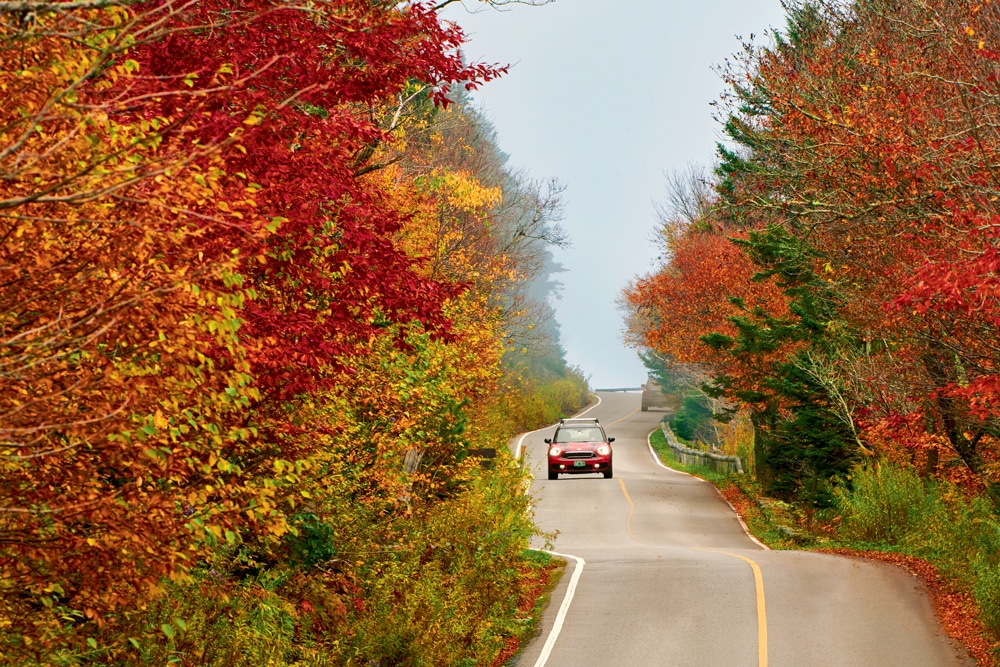
Snugged up against Route 7 in Massachusetts is Mount Greylock State Reservation, where a winding 16.3-mile summit road pays off in prime Berkshire foliage views as well as, at the top, a vista that encompasses five states.
Photo Credit : Corey Hendrickson“Proceed to the route,”
The GPS voice demands, as we have, once again, deviated from her course. Over the past few days, my husband, Joey, and I have made these detours again and again with a shushing of the GPS. As before, we turn off the main road, winding our way around ruts in the pavement. The road feels particularly enchanted—there is a canopy of red and orange that opens into a wide field banked by the Vermont hills all around us. As the narrow road curves, a little house with a sloping roof and a red door appears, a woman staining a chair in her driveway. Up the hill, two blond heads erupt from a carefully raked pile at the exact moment we pass, creating a snow globe of leaves in every color. It is our own little postcard in motion, almost too idyllic to believe.
“Was that real?” Joey asks.
I can only nod. And I know that this moment is why we took that turn.
“Proceed to the route!” the voice demands again, and we make our way back to the main road. Because she is right: This trip is all about the route. We’re driving the length of Route 7, the road that runs from the Canadian border all the way down into Connecticut. Sometimes it’s a major thoroughfare, other times a lonely winding road, but I know few drives that offer so many foliage views and so much art, history, great food, and tempting stops along the way. I’d also wager that Route 7 leads us to more covered bridges than any other, and we are determined to find them all.
Without travel these past few years, like so many others I’ve felt bound to the smallness of my life. I love to go to places where people live, to shop in their stores and experience their sunsets and feel as if the world is much wider than the life I live from day to day. As we planned this trip, I knew it had to feel safe and expansive at the same time. I wanted to explore as much world as I could see, while still easing into the experience of venturing out. Route 7 felt like the perfect anchor.
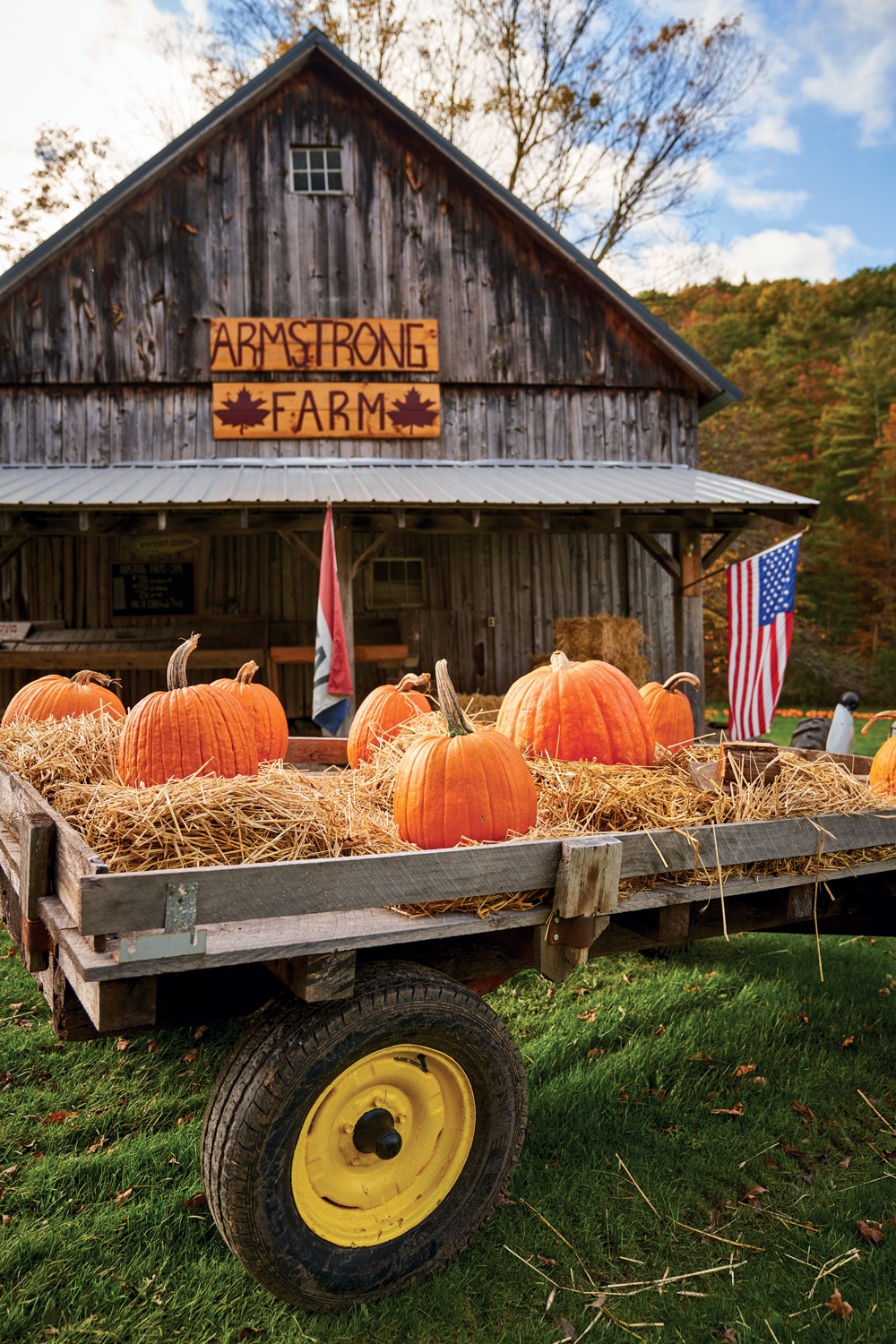
Photo Credit : Corey Hendrickson
The parameters were as follows: Although Route 7 officially stretches from Norwalk, Connecticut, to the Vermont/Canada border, we shortened our route slightly from Shelburne, Vermont, to Kent, Connecticut. It spans just over 200 miles, and, if driven in one shot, would take about five hours. We’d take four days; the road would provide the plan and we’d leave the rest to chance. We would follow a bit of Historic Route 7A as well, and take any turn that beckoned—as long as we didn’t veer more than five miles off the main route—always stopping for pumpkin patches and cider doughnuts, farm stands, breweries, maple creemees, historical landmarks, and even old cemeteries.
There is something so enticing about sticking to one main road, and taking time to know it in its near-entirety. As long as we stay mostly on track, it feels as though anything can happen.
Part 1: Shelburne, Vermont
I am in an Adirondack chair at the very top of the world. The air is cool but the sun is warm, and the leaves are going out with a bang, with reds and bright golds almost electric against the blue of the sky and the deeper blue of Lake Champlain. We have claimed the two best chairs in the gardens of the Inn at Shelburne Farms, the grand main house of the Vanderbilt estate that has now become the 1,400-acre campus of a working farm and educational center. When I told friends that we would start our trip here, in Shelburne, I encountered the same response more than once: “Shelburne Farms is one of my favorite places on earth.”
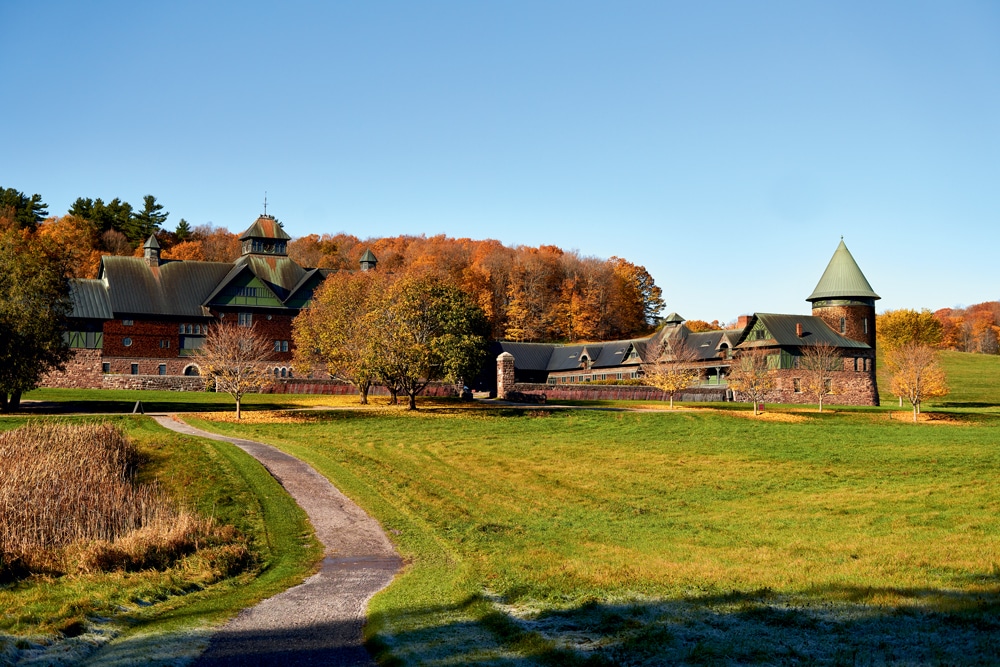
Photo Credit : Corey Hendrickson
Every step we walk here pulls me deeper into that fan club. My friend Emily works at O Bread Bakery on the farm, and we begin there, poking our heads in the door to breathe in the breads and pastries filling the racks. Emily meets us outside, shielding her eyes from the sun with a raised arm, shooing us off toward her favorite nooks of the property with a paper bag full of warm brioche chocolate rolls.
Exploring the farm, there is a simultaneous feeling of fantasy and real life. The place itself is so grand in scope that it’s hard to connect it with anything other than its Gilded Age history. But in the end, it’s not a museum but a working farm, an educational nonprofit dedicated to sustainability, food, and land stewardship. And as we make our way through the cheese-making room, both past and current missions coexist with such clarity that it inspires conversations of our own dreams as we walk the wide gravel paths. Somehow, with history so close, it makes me more hopeful.

Photo Credit : Corey Hendrickson
A five-minute drive brings us to the Shelburne Museum, a collection of Americana housed in 39 structures across a 45-acre property. This is an homage to the beauty of everyday spaces and useful objects. My favorites surprise me: the fully restored Ticonderoga steamboat, which we wander from end to end; the bustling printing shop; and the Horseshoe Barn, a massive building that holds an array of horse-drawn carriages that includes a 1910 school bus sleigh—basically a beat-up orange shed on skis with two long child-sized benches and a small woodstove that once carried children in northern Vermont to their one-room schoolhouse. It has less beauty and more use than its carved and gilded neighbors in the barn, but something about that little bus elicits an image as clear as if I had been there myself, a mother to kids from another time, bundled in wool coats as they compared the clouds of their frosted breath.
We come across the first covered bridge of our adventure, a rare two-lane bridge that originally spanned the Lamoille River in Cambridge, Vermont, but was moved to Shelburne in 1949 by museum founder Electra Havemeyer Webb. She had the massive bridge dismantled and reassembled at great expense because, as we learned on the banks of the pond that now holds the bridge, “it was just too good to resist.” This bridge has elements of everything I love about Shelburne—it is grand and stunning and deeply steeped in history.
A word about covered bridges: Over the course of our Route 7 trip, the bridges will somehow surprise us every time, even when we know we’re looking for them. Covered bridges are, in their essence, nothing particularly magical. They are simply timber-truss wooden bridges topped with a protective roof. But in order to understand what is so special about a covered bridge, you need only to step inside one. Is it the shifting sensation of wood over water? The light as it comes through the entrance and exit, creating a quality that is both dim and bright at the same time, turning everyone who walks through into a Rembrandt? Or the acoustics that reflect and deepen every tone, so we find ourselves singing just to hear the sound? Whatever it is, the bridges pull us like children to a playground, and we stop the car every time and wander through each bridge, testing the sound, stomping on the floor, making wishes and holding our breath according to the old superstitions, noticing what makes each one both different from and the same as the others.
Part 2: Southern Vermont
We come upon our next covered bridge by accident. The Hammond Bridge in Pittsford has the feel of the forgotten. It’s blocked off and beloved by bittersweet vines, and I imagine another time when the bridge was the only way from one place to another. It all feels lost and lovely, waiting to be found.
A bit farther south, we drive around the streets of Rutland, awestruck by the larger-than-life murals that adorn buildings seemingly around every corner. The murals began in 2010, and every year more artwork appears, stopping visitors in their tracks.
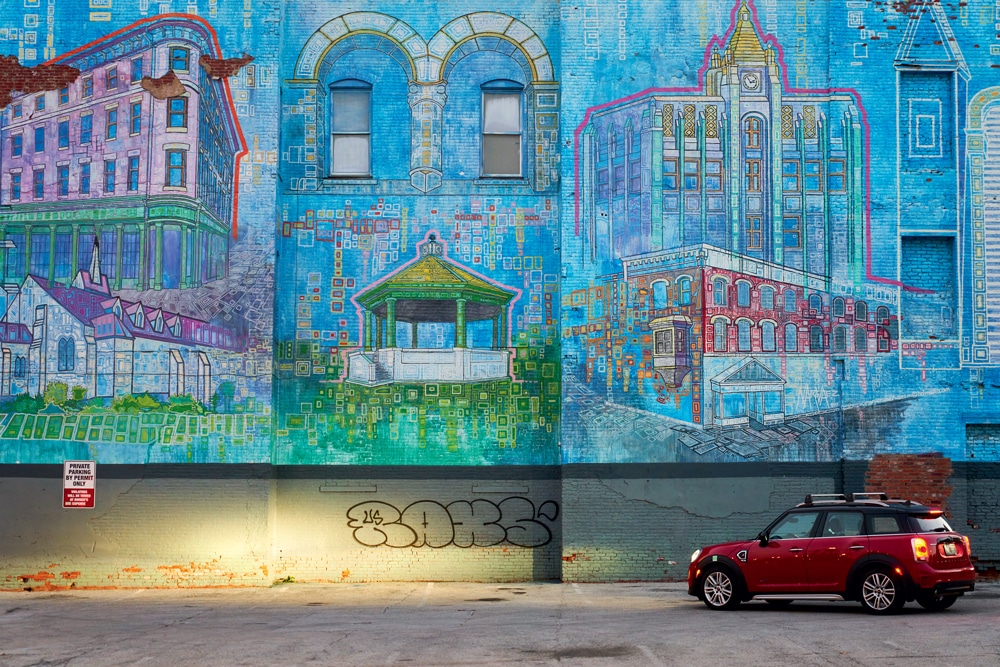
Photo Credit : Corey Hendrickson
When we leave town, Route 7 leads us about 25 miles toward Manchester, and right before town we join the Route 7A byway and grab a burger at Zoe’s Double Hex before heading to Hildene, the grand home of the only child of Abraham and Mary Todd Lincoln who grew up to have a family of his own.
Robert Todd Lincoln first came to Manchester in 1864, when his father was working to hold the country together. Years later, when it was time to build a summer house for his family, he discovered this site. The 1905 home is perched on a hill between two mountains, and I wander the manicured gardens to the little observatory that seems almost to float over the trees.
Just south of Manchester off Route 7A we take the Skyline Drive toll road to the top of Mount Equinox.The twisting 5.2-mile climb brings us to the 3,848-foot summit and the viewing center built by the Carthusian monks who reside on the mountain, and it’s at least 20 degrees colder at the top than at the base. We are surrounded by mountains on all sides: the Adirondacks, the Catskills, the Berkshires, and the Taconics. The colors of the leaves are more vivid than any we’ve seen on the trip so far, and the clouds, near enough to touch, squeeze out a few snowflakes to add to the vision. And then, armed with the little sheet of instructions handed solemnly to me in the welcome center—“Stop regularly to give your brakes a break!”—we wind back and forth down the mountain, stopping at every pullout to take in the color.
We are not in a race to see everything on our way. But these hills inspired Robert Frost, and so we know we want to stop in Shaftsbury to visit the Robert Frost Stone House Museum, a bright little stone and clapboard house with an orchard in the yard. The house is one of the oldest around, a rare example of Dutch Colonial architecture built in 1769, and now maintained by nearby Bennington College. It’s almost the end of the day, and the light moves through the two main rooms of the house that compose the museum. I chat with the Bennington student working the front desk—we talk about the world opening up again, and she tells me how nice it is to have people back in the museum.
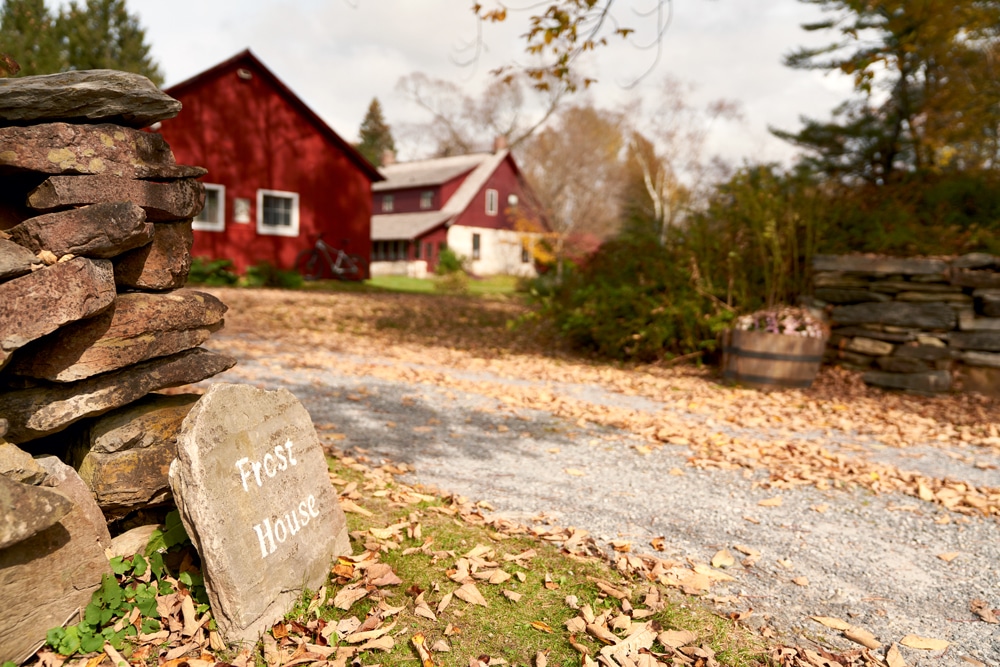
Photo Credit : Corey Hendrickson
On our visit, the featured exhibit is a room full of the erasure poetry of Mary Ruefle, Vermont’s poet laureate. Frost wrote his most famous poem in this house, and Ruefle’s exhibit includes her take on “Stopping by Woods on a Snowy Evening,” which has been written out on the wall in the main room. Erasure poetry works with existing text, blacking out certain words to create a new work. Here, in this little light-filled house, I am floored by the transformation from that moment in time to this one, the past made present. In its new form, the poem is called simply “Stopping.” I think I know / now / a / frozen / year / The only sound’s the weep / of / promises / and/ sleep.
Part 3: The Berkshires
As we pass into Massachusetts, the towns grow denser, the bright orange hills tighter and gentler on either side. This is familiar territory for us, closer to home, but we steer away from our comfort zones, seeking out new views and new pathways.
We’ve done this stretch as tourists before, back in 2015, when Joey and I endeavored to walk the length of Route 7 as it extended through Berkshire County from Vermont to Connecticut, a 56-mile stretch that doubles as Main Street through most towns along the corridor. That trip was all about taking what felt familiar and changing its context. For eight days, we walked the routes we had driven for years, but we took them slowly, on foot, developing new relationships to the places we’d grown tired of driving by day after day. It was so nice to be back on this stretch of road as a tourist, although this time, by car, we’re using the familiar as a springboard for new experiences. We watch the sun set on Mount Greylock before wings and a beer at the Olde Forge, and spend a night in downtown Pittsfield at Hotel on North, the swanky boutique hotel that embraces Berkshire idiosyncracy, each room different from every other.
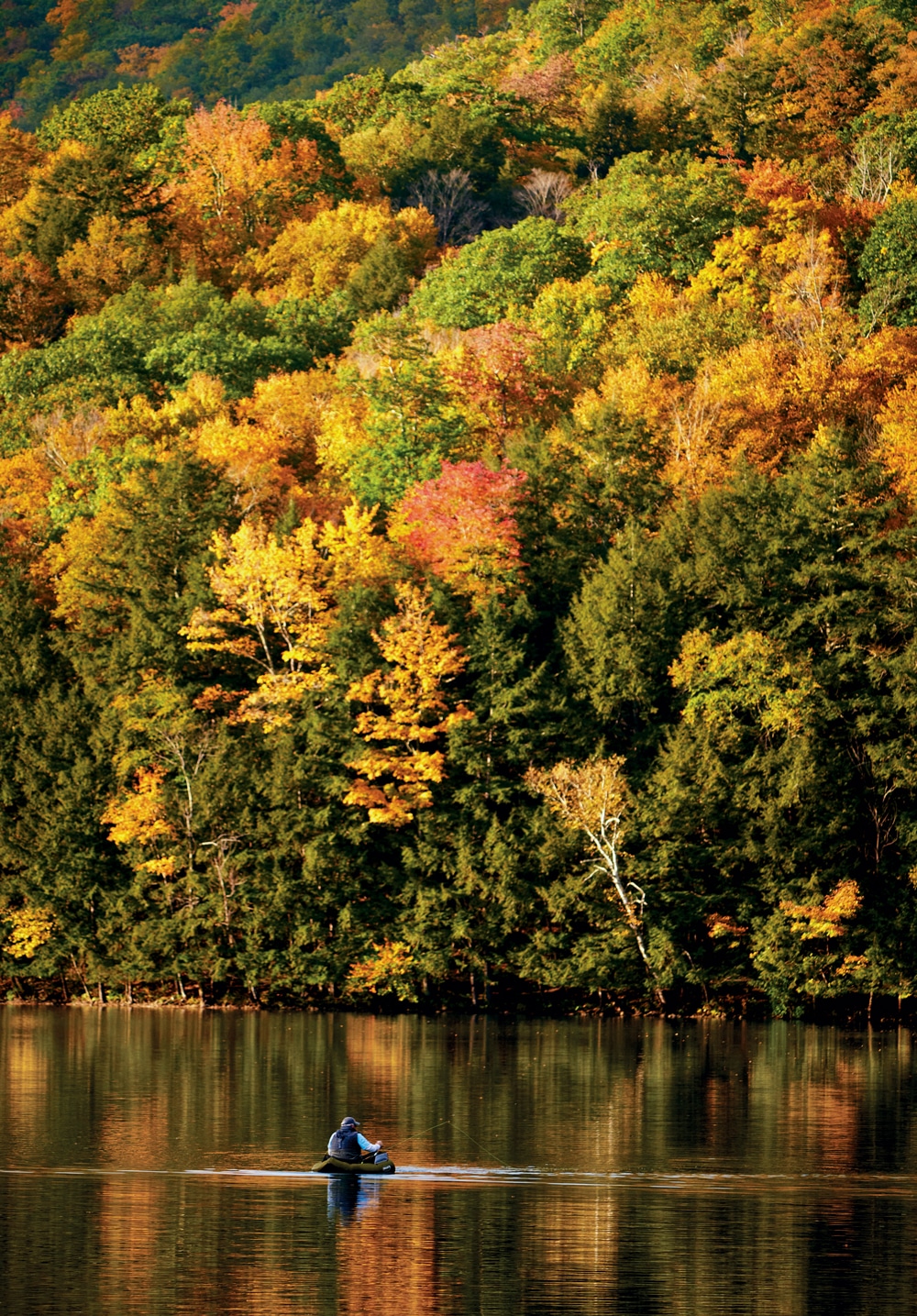
Photo Credit : Corey Hendrickson
Stockbridge has one of the most famous Main Streets in New England, because while many towns look as if they’re “right out of a Norman Rockwell painting,” Stockbridge is literally the town that Rockwell painted. It’s also thick with history—from the house and gardens at Naumkeag, to Mumbet’s grave, to the Norman Rockwell Museum, complete with his fully reconstructed studio. We wander down this bit of Route 7 that makes up the famous Main Street, and stop for a drink on the rocking chairs of the Red Lion Inn’s porch before heading to dinner at Once Upon a Table. The restaurant is under new management, and the tiny space is updated from the old kitschiness I remember, the now-white walls glowing in the low light. We share exquisitely cooked lamb chops with couscous and peas, and a beet salad that sits on a bed of something creamy I want to lick right off the plate.
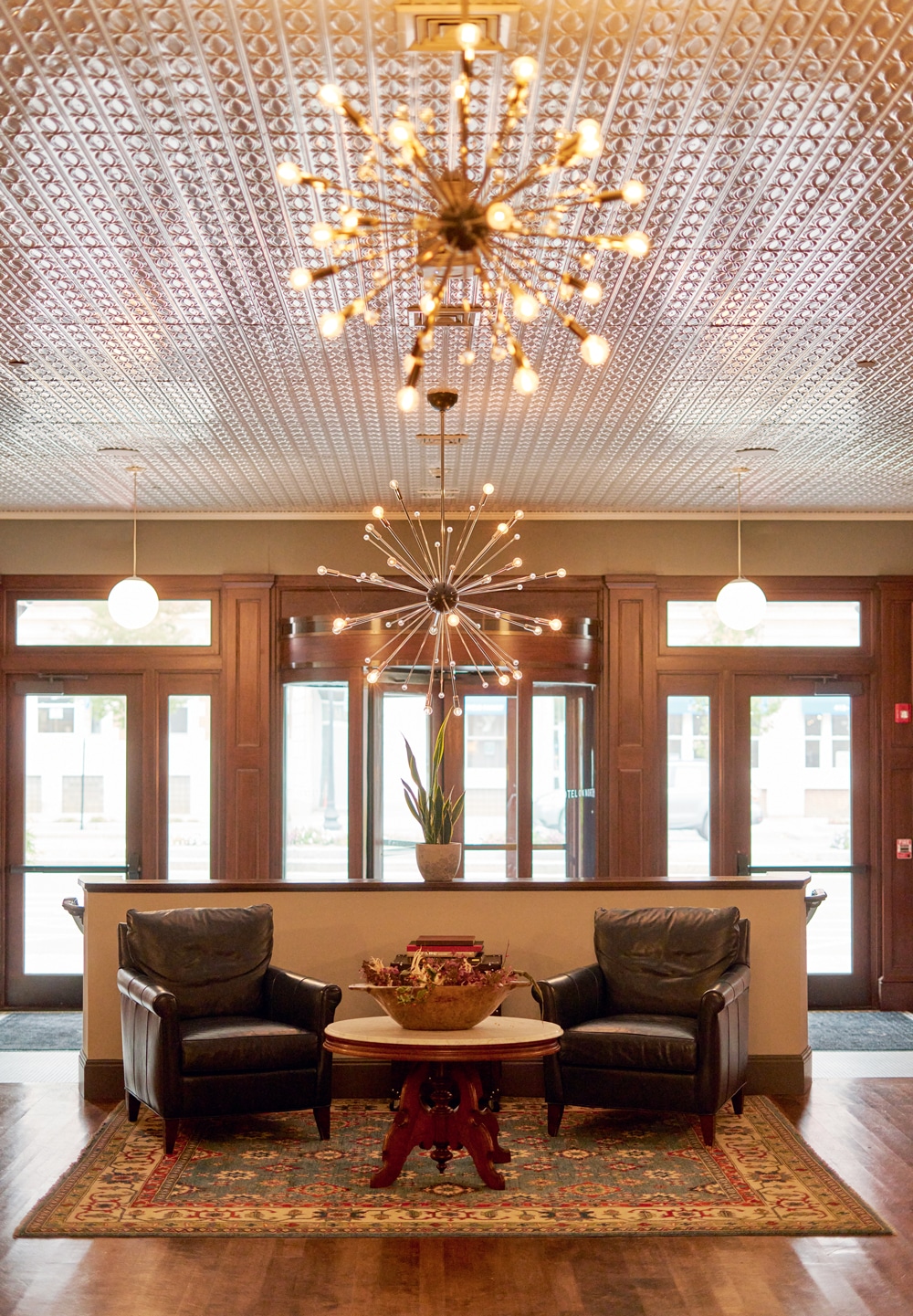
Photo Credit : Corey Hendrickson
The Berkshires have always had an inherent quirkiness, a lure to those who are outside the norm. In past centuries, writers and artists have been drawn to this remote county, and there is evidence of their work and presence all along Route 7. We pay tribute as we come upon them: Thoreau’s words on the top of Mount Greylock; Edith Wharton’s grand home away from the stuffy society of New York and Newport; the spot on Monument Mountain in Great Barrington where Melville and Hawthorne took refuge in a rainstorm and began a lifelong friendship (or romance, depending on who you talk to).
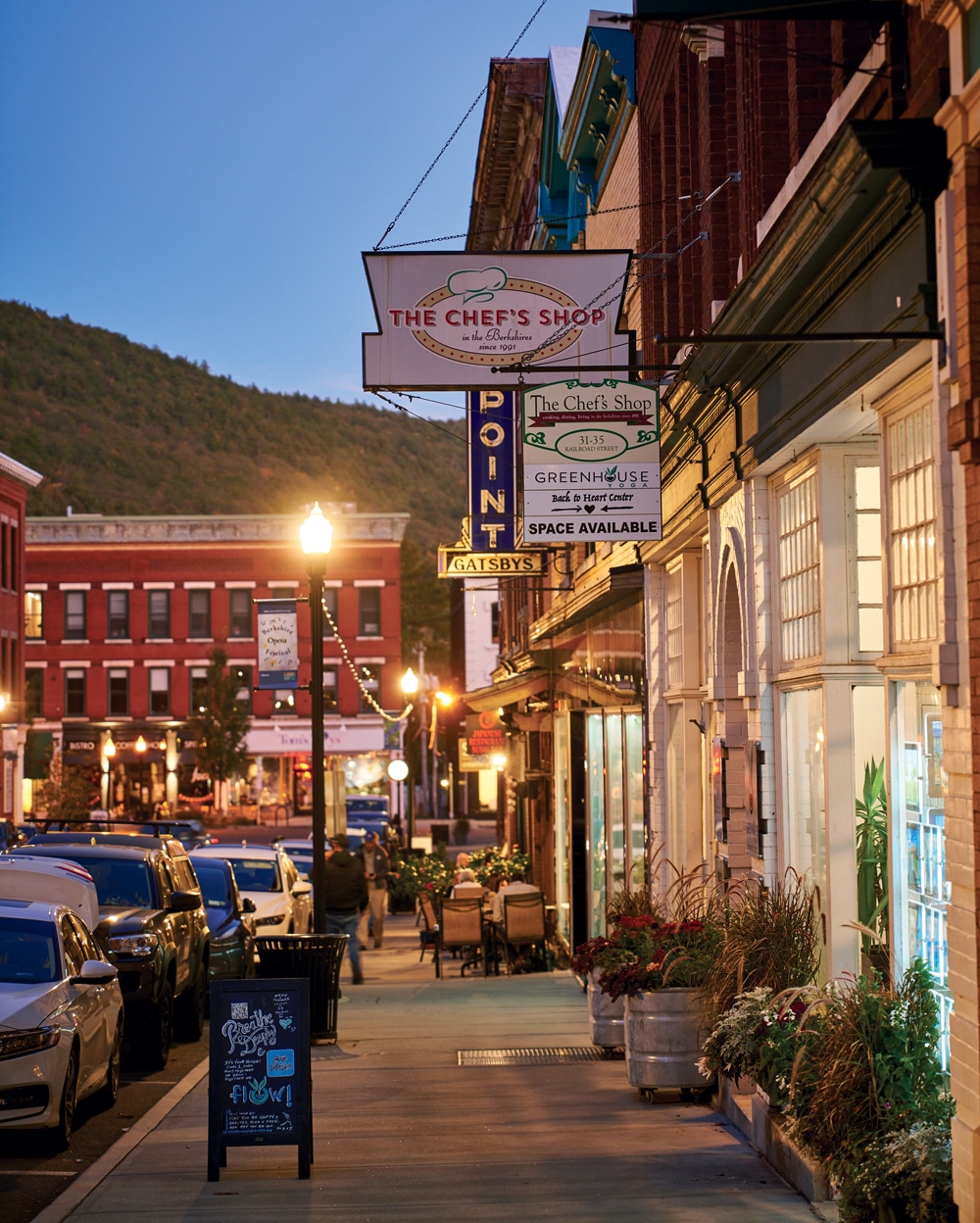
Photo Credit : Corey Hendrickson
And our next covered bridge? Spanning the Housatonic River, which lines much of this part of Route 7, the Old Covered Bridge appears in Sheffield, just before Massachusetts runs into Connecticut. It is a common place for neighborhood dog walks and, in 1969, was apparently the site of the most verifiable UFO sighting in U.S. history. I find this bridge, like the others, to be oddly emblematic of the region around it. Like the Berkshires, it is a perfect mix of past and present, bustling and well visited, and decidedly offbeat. It takes a change of perspective to see my own county as a visitor, but here, driving through, I see it and I love it.
Part 4: The Litchfield Hills
As Route 7 heads into Connecticut, it becomes more deeply tied to the Housatonic River, the road a dance partner to the water. Our first stop is in Falls Village, a tiny segment of Canaan that feels like a step into the 19th century, complete with a grand Victorian inn. We wander into the Falls Village Café for an egg sandwich, and end up next door at Furnace–Art on Paper Archive. We take in the current show, and then explore the gallery itself, which has rows of drawers of artwork that can be pulled out and inspected. We pore over it all with the person who is working at the gallery for the day. “I usually teach swimming,” we are told. “But I love being around all this great work.”
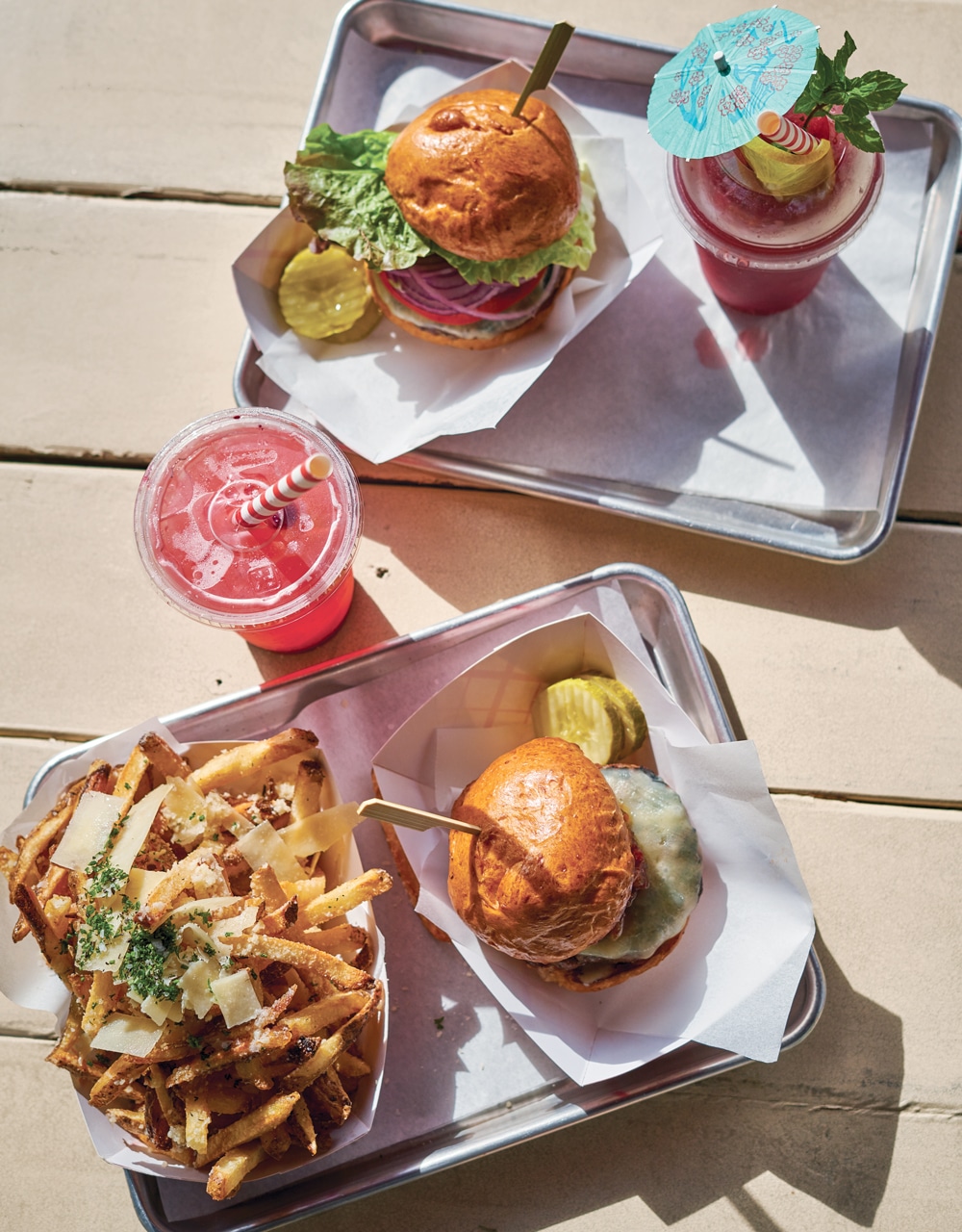
Photo Credit : Corey Hendrickson
I’ve always thought of Vermont as the be-all and end-all of foliage, but as we drive through Connecticut, everything is more vivid—deep maroon, mustard yellow, poppy orange. There is ever the sound of rushing water, and each place we stop, whether a farm stand or a junk shop, seems to have a grassy bank and a picnic table out back. We come to a covered bridge I have known about but never seen, in West Cornwall. This bridge is fully integrated into the town, the first that we can drive over. It feels so Connecticut to me—it’s less past-meets-present than the past is alive and well. It’s almost as if we have traveled back in time ourselves, and that this road, following the same path it did even before it was called Route 7, dictates not just the place, but also the time to which we travel.
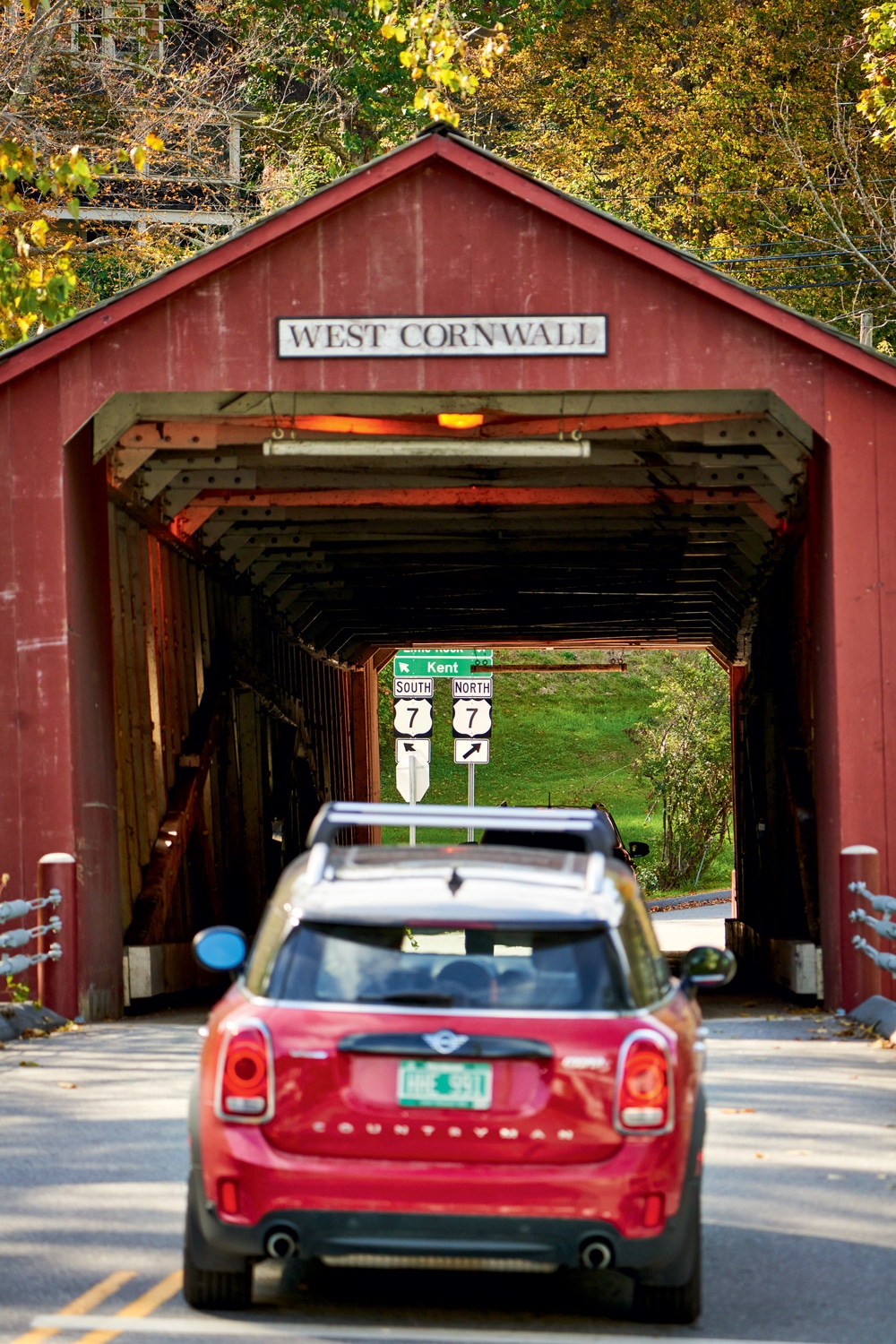
Photo Credit : Corey Hendrickson
Before we end our trip with a night in Kent, we spend an afternoon at Kent Falls State Park. The falls are a true wonder of nature, with a staircase to the sky that we ascend to the very top. The falls drop 250 feet in a quarter of a mile, and we follow them back down until they empty into a calm little brook that flows to the Housatonic. The day is warm, and we take off our shoes, stepping into the water downriver from a little girl who splashes her way across the stones. We sit on the banks of the brook, watching everyone around us celebrate this warmth, this place, this day. Even here at this waterfall in Connecticut, I hear German, Japanese, Hindi. And I think of where we began, on the shores of Lake Champlain, just a little further up this wonderful road with all its adventures, waiting to be found.
Ready to plan your Route 7 road trip? Discover dozens of editors’ picks for what to see and do, and where to eat and stay, at newengland.com/best-of-route-7

